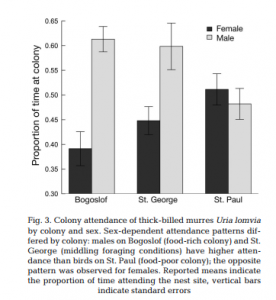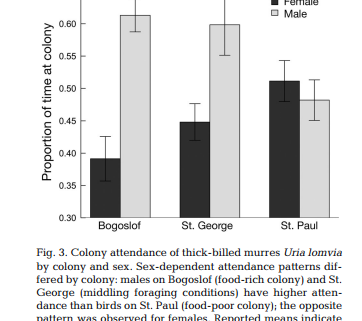Sea Bird Telomeres
By Dave Lestino, SRC intern
Telomeres are located at the ends of each DNA strand. They can be thought of as the plastic tips of shoelaces, and protect the chromosome from deterioration. Although telomeres can’t measure exact chronological age, they can be used to measure individual quality. Use of telomere length, as a quality marker, is increasing as seen in handful of studies between 2004 and 2015. In most species, it has been observed that telomeres shorten overtime, and length corresponds with survival, life-span and reproductive success. In a study by Young et al. in 2016, telomere lengths were compared to quality markers, such as environmental condition, in the thick-billed murre.

Methods
Young et al. assessed individual quality through parental investment behaviors (trip rate and nest attendance), body condition and physiological stress (baseline corticosterone or CORT). Their samples came from three colonies of thick-billed murre (Uria lomvia), which is a species of long-lived seabird. They sampled 97 individuals from 3 colonies (Bogoslof, St. George and St. Paul) in the Baring Sea, each living under different environmental conditions. The colony on Bogoslof had easy access to nearby food sources, while St. George had access to distant but reliable sources and St. Paul had access to nearby but unreliable food sources. These food sources relate to good, intermediate and poor environmental conditions comparatively.
Young chose this species because murres are known to adjust time budgets as conditions in the environment change, in order to offer consistent levels of parental investment. Thus, telomere length would indicate quality indicators and not age as the underlying driver of telomere length. The authors predicted that longer telomere length would be associated with low baseline CORT, high body condition and high parental investment. They also predicted poor environmental conditions should strengthen the above relationships. Chick rearing murres were captured, weighed, sampled for blood and fitted with Cefas G5 loggers to record time, temperature and depth pressure every 2 seconds. After 3 days the birds were recaptured and skeletal measures were taken. In total 101 birds were captured, but due to some sampling errors the final analysis consisted of 97 individuals.
For telomere length and baseline CORT assays were completed on the blood samples. Parental investment was based on nest attendance and rate of foraging trips. To calculate nest attendance, they looked at what proportion of total time was spent at the colony, measured by a Cefas loggers mounted on the birds, recording temperature and depth. Temperatures reading higher than air or sea indicate incubation, while changes in incubation temperature marked the beginning and end of a foraging trip. Trip rate was then determined by dividing the number of trips by the total deployment time. Response variables (CORT, body condition, trip rate and attendance) were analyzed with linear models in the R environmental statistic program.
Results
The results showed that under good environmental conditions CORT was higher in birds with shorter telomeres. In poor conditions however, this was not strengthened as predicted but instead was reversed. Birds with longer telomeres had higher levels of stress. This implies that under stressful conditions, such as the poor environment at St. Paul, younger birds will be stressed even with high individual quality. Older more experienced birds however can maintain moderate stress levels. Predictions that telomere length could predict parental investment were incorrect. A paper by Elliott et al. in 2015 shows that parental behaviors don’t change with age. Murres have shown to change foraging strategies depending on distance to food sources. The interaction of sex and colony for explaining attendance patterns can be seen in Fig. 3. In conclusion, the authors found that telomere length relates to stress levels with environmental factors acting as important mediators. As habitats around the world decline, these findings can hopefully help in futures studies to determine individual quality of species in degraded areas
References
Young RC, Barger CP, Dorresteijn I, Haussmann MF, Kitaysky AS (2016) Telomere length and environmental conditions predict stress levels but not parental investment in a long-lived seabird. 556, 251–259.




Leave a Reply
Want to join the discussion?Feel free to contribute!